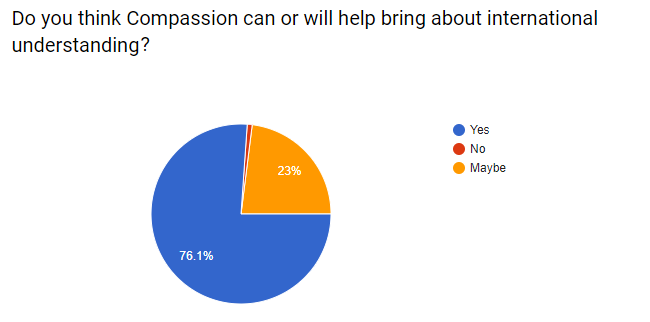Developing International Understanding with Compassion
Authored by: Rushil Chaudhary and Sriman Goel from Doon School, Dehradun, India
Summary
On flipping through the pages of the Oxford dictionary, one would see that compassion is defined as simply, the word ‘pity’. But in the context of reality, it means much more. An intricate mix of feelings, compassion is an essential trait of humanity which defines the very ideals of civilisation, of being together. It means caring for each other by not simply pitying, but by having a genuine incentive to reduce someone else’s suffering. Hence, being indispensable to human character, it is only rational that we check whether the world is compassionate enough. Instead of bluntly claiming that compassion has reduced owing to rapid globalization, we have to look at the local platform where an individual exhibits compassion. So for our paper, we will look at the levels of compassion in the new student generation, primarily in the context of their life in school.
Introduction
We decided to understand how the students in our school viewed their compassion levels themselves. We designed a simple survey with the help of Google Forms and consequently collected data on the students’ belief of their compassion for others in society. To ensure the reliability of these student responses, we decided to understand the teachers’ viewpoints as well. As we later discovered, this proved to be crucial as two different sets of opinions emerged.
Process
In our long-answer questions on the importance of compassion in the context of international understanding, we received many inputs on why compassion is a requirement. These responses addressed both the lack of compassion as well as the need for it today in a world that is rapidly ‘turning digital and losing human sentiment’. We saw a few recurring ideas in these responses and saw fit to reduce them to appropriate codes. The most relevant codes are listed below, along with their percentage frequency of occurrence, to quantify the need for compassion.
Analysis
Student survey data
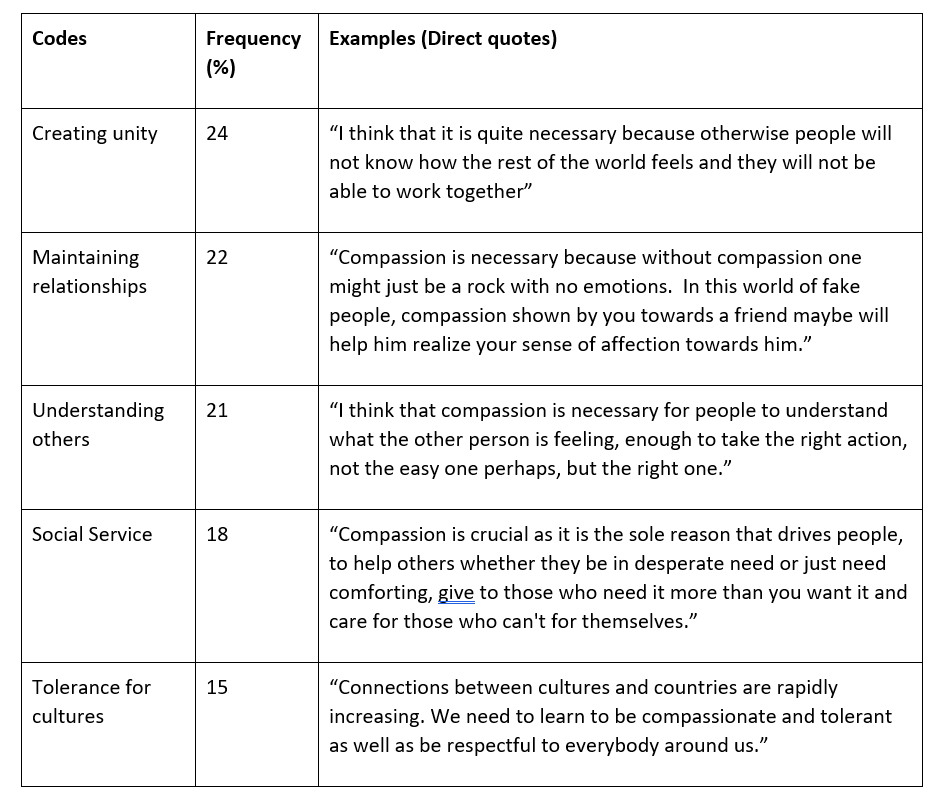
Teacher Survey Data
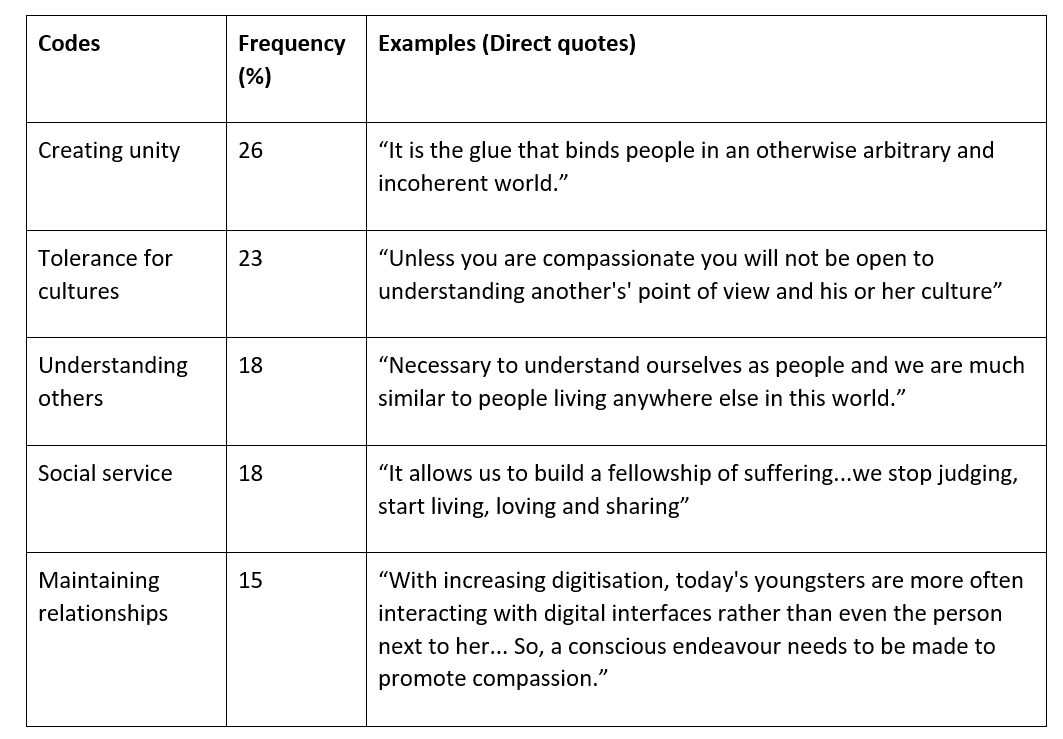
As the data demonstrates, compassion is widely viewed as crucial to the student generation for 5 major reasons (codes), and to prevent the devastating outcomes of a world where students lack compassion. As characterised by many teachers and students alike, there is a clear realisation of a rapid digital movement and increased tensions between the varied strata of society. A viable solution is the promotion of compassion leading toward a significant improvement in the 5 areas mentioned above as codes. Particularly in the context of international understanding, compassion is of paramount importance because of the power it has to ‘bind people’ together. A feeling of ‘togetherness’ or the codes of ‘Creating Unity’ and ‘Tolerance of Cultures’ is what is common between the research codes of International Understanding and the codes above. This unity can only be evoked when people understand each other, hence the choice of the third code ‘Understanding others’. This code is further connected to the fourth idea (Maintaining Relationships) as well – as every relationship needs the unique mutual understanding and affection, that only compassion provides. Lastly, the ultimate aim of every welfare-society is equality, providing for those in need. Compassion brings incentive to an individual and pushes one to act upon these emotions and the ambition of creating unity, ‘Social service’ is the result towards the goal of International Understanding. This is why we chose our codes, as they work in tandem with transforming compassion into action (in the form of service) beneficial for society.
These are some of the visible reasons for compassion’s presence in our generation. But there is a subtle, more convincing reason for compassion’s importance, It is the problem of misconception caused due to the existence of different perspectives, and is clearly visible in the two sets of data obtained from our surveys. Both these surveys focus on the students’ capacity for compassion, but with one being from the concerned students’ point of view, and one from credible teachers. It is easy for these teachers to view compassion among the students due to the amount of time teachers and students spend in each other’s presence in a boarding school (making teachers credible sources).
Teachers’ Survey Data*
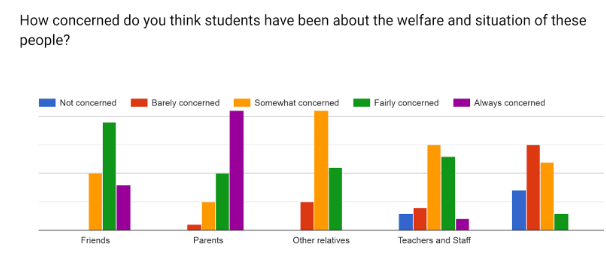
Students’ Survey Data*
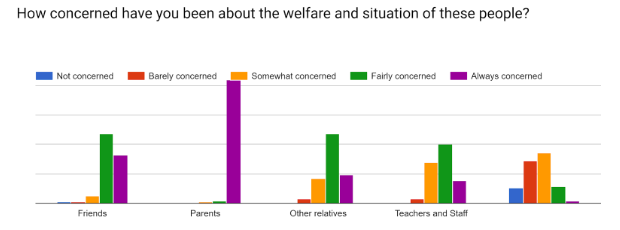
*The last category in both these charts is ‘Unrelated People’ i.e. Anyone you, as a student, don’t know of. This is the set of bars to the right of ‘Teachers and Staff
From the above-displayed bar charts, a disturbing difference is noticed between the opinions of the two different perspectives. The contrast between these two sets of data demonstrates that compassion is viewed as abundant by students, but by observers like teachers, it is critically lower. This further emphasises the importance of compassion underestimated by those who need it the most – i. e. The student generation itself. Living in a globalized world where digitalization and indifferent capitalization is rampant, compassion’s importance is only growing.
One more point of note from the two sets of data is that the rightmost set of bar graphs – ‘Unrelated people’ – has a clear lower level of concern from students than for anyone a student may know. Despite the obvious concern one has for someone they know of our results show that students are more rather ‘Not concerned’ about the welfare and situation of these people. As students and teachers themselves are agreeing that students are not concerned about these people, it reinforces the necessity of compassion. It is this attitude towards other humans in society that hinders internationalism. The stepping stone for a global community must include, first, concern for the welfare of others in this community. Since global interaction will be low, few people will know each other, yet concern and hence compassion for each other is a prerequisite to achieving internationalism.
As our personal understanding of compassion goes, our belief matches those whom we have quoted. We believe compassion is necessary as a particularly human attribute – it is the virtue of a civilised society. Working and living together in a harmonic manner requires a level of understanding and unity among people of that community. And as we pose this question in terms of a global community, we are forced to realise that this virtue is required to create an effectively functioning society. As we see today (and this is matched by our data on the same in the smaller community of our school), this sentiment of humans is not particularly focussed upon consciously in light of the conflict present between any group of people living together. A society will only be able to develop when it’s able to understand what every such group wants, that is when all-inclusive welfare ensues. For maintaining this, compassion becomes indispensable, and is hence, becomes extremely vital. For instance, in the incident quoted by one of our teachers, we see how compassion can play a role in uplifting some and creating a closer level of equality that is needed in society.
The example is quoted here: “There was a student who had severe congenital motor-skill issues, so he was unable to play sports or take part in most activities which allowed others to showcase their talents and skills. This student, however, was passionate about playing the drums although he was understandably not the best at it. When the time for the inter-House music competition came around, his friends approached me (I was their housemaster then) and requested me to allow him to represent the house for drums, so that he also, could enjoy some sense of achievement after having contributed towards the House. I was proud of these kids and deeply moved by their thoughtfulness and compassion even though it meant that the house would certainly not win in this event.”
We would also like to expand upon what would occur if compassion is lacking in a system as complex as the global community. Without the ability to empathise, we would see conflict being aggravated to a heightened degree since the only virtue that would at all deter this conflict from taking place would be missing from individuals in this society. Without feeling for another person, or without understanding or relationships with someone else, a community will cease to exist in itself. Society will turn devastatingly individualistic leading to chaos and the opposite of international understanding.
We further understood how can compassion be promoted among students, i. e. How can compassion be taught, essentially? We polled to understand how this could be achieved and found a few common activities that would build both compassion and lead to international understanding. Our results included all the categories listed in the bar chart below.
Activities that promote Compassion at our school

(‘Midterms’ are treks that involve large groups of students and teachers living in the wilderness together for 5-6 days. These take place biannually at our school.)
Due to compassion’s undying importance, it’s imperative that we inculcate compassionate behaviour in students from a very young age itself. Schools can act as excellent platforms for developing this, as they offer various activities/experiences that can develop this attribute in a student’s character.
From the chart, it’s clear that students do develop a feeling of compassion when they participate in activities such as Midterms, social service and exchange programmes. The whole concept of boarding life and interacting with elders such as teachers also proves to be instrumental in initiating compassionate behaviour in students. What’s common in all of these examples is that another living entity is always involved. That depicts a core characteristic that compassion possesses – it usually only comes into play when interactions between different living objects take place. That’s when one learns the values of selflessness, of tolerance, of unbiased, mutual understanding. So, anything which creates interactions between unique people or organizations should strengthen the value of compassion, making it our aim to thoroughly promote such activities.
Conclusion
In conclusion, we would like to reveal this pie chart here, which depicts how an unsurprising ¾ stating that compassion does assist in creating international understanding. Only a paltry 0.9% deny. This tells us that our student generation does actually consider compassion to be a possibility toward acquiring International Understanding. Now what’s left is implementing this virtue in our daily lives to make this world a kinder and more understanding place.
